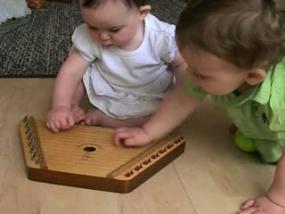Infants Explore the Harp

Olivia and Michael explore an unusual object, a toy harp. At first Olivia fingers the features that protrude, the posts that the musician uses to tune the harp. The teacher models how to pluck the wire strings to make a musical sound. Olivia is intrigued, but on her way to try this new strategy, she cannot resist fingering the protruding posts once again. She changes her movement from a pinch of the post to a grasp of the string, followed by a pluck made by swiping the wire strings with her fingers. This progression reveals how infants think. They want to activate a new movement (the one seen) but upon seeing the posts, the old pinching movement is activated. Infants have a tendency to repeat a previous action upon presentation of the eliciting stimulus, sometimes called “percept bound.” Learning often requires the suppression of a habit. Thankfully the strength of Olivia’s mental image of the teacher’s action retains sufficient power to cause her to shift, first to a grasp of the strings (half way between a pinch and a pluck), and then to the pluck, which could have been elicited in part by both the mental image of what she saw plus the feel of the wire upon her finger tips. This is how infants work to incorporate something seen into something done. Imitation is hard work and in no sense do infants “copy” what they have seen. They have to suppress more dominant habits in order to reconstruct or invent the witnessed actions by understanding how and when to use them. Watch to see how Olivia continues to explore the harp in terms of what this instrument affords: pinching, plucking, and poking.
Michael did not witness the teacher’s plucking of the strings. He holds a large rattle (maraca) and after shaking it in the air he uses a similar movement to drum on the harp with it. He seems to move back and forth between assimilating the harp to his scheme “something to drum” (the flat surface) to his scheme for “something to poke” (the hole). The hole however has thin obstacles, the wires, and this obstruction seems to perplex Michael. The wires restrict access to the hole, both for the maraca, as he drags it across the face of the hole, and for his fingers, as he attempts to insert them into the hole.
We have to wonder why Michael, unlike Olivia, works so hard to lift the harp. One reason could be that he wants to align the angle with his maraca so he can try to insert it into the hole. The other reason could be that he does not like how poorly the stringed side serves as a drum and therefore shifts to the other side that is unencumbered by the strings. Clearly his behavior is intentional, and it is important to speculate on his goals. Understanding an infant’s goals reveals the intelligence of his strategies.
The most marvelous segment of this clip comes when Olivia extends her “plucking” strategy to a new surface, the upside down pot. Learning depends on the infant’s attempts to try an old strategy on a new object. As you can see, the new object (the pot’s bottom) has no strings, only striations in the metal. And as you can see, she modifies her strategy from a finger flicking pluck from the wrist to a place-palm-on-surface scratching action. Olivia is both assimilating the pot to the harp surface, and accommodating her strategy to the physical nature of the surface of the pot. She aborts further attempts to make noise on the colander because it does not yield the sound effects she desires.
In summary, this clip illustrates how Olivia suppresses the habit of pinching, modifies her pinch to a grasp and then her grasp to a pluck, generalizes the pluck to the pot, modifies her pluck to a scratch, and discriminates the colander from the pot. She clearly is thinking at a high level to figure out how the world works. As is Michael as he tries various ways to enter the hole and drum the surfaces.
